UN Treaties Are FRAUDULENT
LEGAL MEMORANDUM
Is the United States in a Treaty Relationship
with the United Nations?
Questions:
- Is any participation and funding of the United Nations (and its subsidiary and/or associated organizations) legal?
- Did the 1945 signing of the United Nations (UN) Charter and the US Senate vote authorizing the President’s signature create Treaty obligations binding on the United States?
- Was the UN Charter ratified as a Treaty by the US Senate or is it merely a contract between the United States and an international association?
- Is the absence of the required deposit of the formal Instrument of Ratification evidence that the UN Charter was not lawfully ratified?
- Are the UN Charter and related UN documents (such as the WHO Constitution) binding on State governments under the Supremacy Clause of the US Constitution?
- Are the UN Charter and related UN documents binding in any way on the United States?
- What binding obligations does membership in the UN (and its subsidiary organizations) impose on the United States?
- Was the manner in which then President Harry S. Truman presented the Charter to the US Senate unconstitutional as conceived in deceit, maintained in deceit and thus ultra vires, beyond the power of the President and Senate?
- Are any signatories to the UN Charter bound, as if by a “Treaty”, to either the UN or its Member States?
Facts & Law:
[A] At the end of World War Two the victorious powers negotiated the establishment of a successor to the League of Nations, to be called the “United Nations.” The UN Conference in San Francisco, in the spring and early summer of 1945, following the defeat of Nazi Germany, adopted the Charter and it was opened for signatures. President Truman was present at the Conference when the US Secretary of State signed the Charter, June 26, 1945. [1]
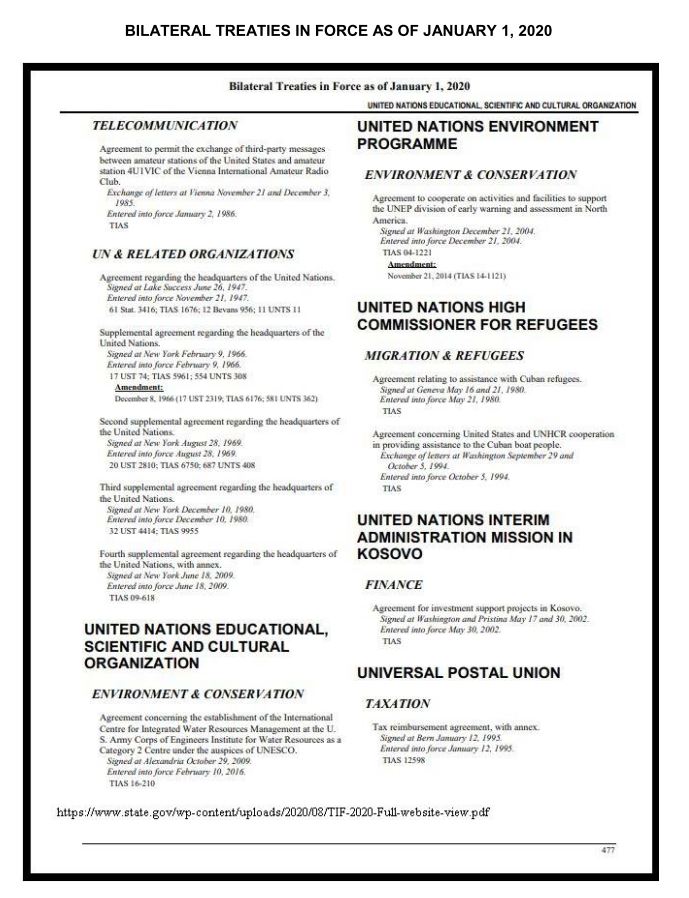
[B] In Article 110 the Charter requires its ratification:
- The present Charter shall be ratified by the signatory states in accordance with their respective constitutional processes.
- The ratifications shall be deposited with the Government of the United States of America, which shall notify all the signatory states of each deposit as well as the Secretary-General of the Organization when he has been appointed.
- The present Charter shall come into force upon the deposit of ratifications by the Republic of China, France, the Union of Soviet Socialist Republics, the United Kingdom of Great Britain and Northern Ireland, and the United States of America, and by a majority of the other signatory states. A protocol of the ratifications deposited shall thereupon be drawn up by the Government of the United States of America which shall communicate copies thereof to all the signatory states. [2]
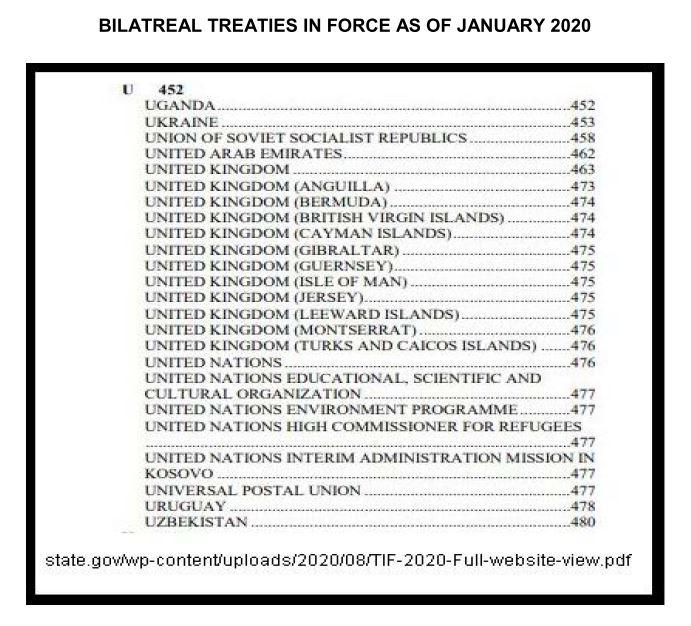
[C] Harry S. Truman, the President of the United States, and a former Senator, personally took the Charter to the US Senate asking for ‘advice and consent’ to join the United Nations.
[D] On July 28, 1945 the Senate held a Roll Call vote, as the Congressional Record shows [3]:
The Congressional Record states:
“Two-thirds of the Senators present concurring therein, the resolution of ratification is agreed to, and the treaty is ratified.”
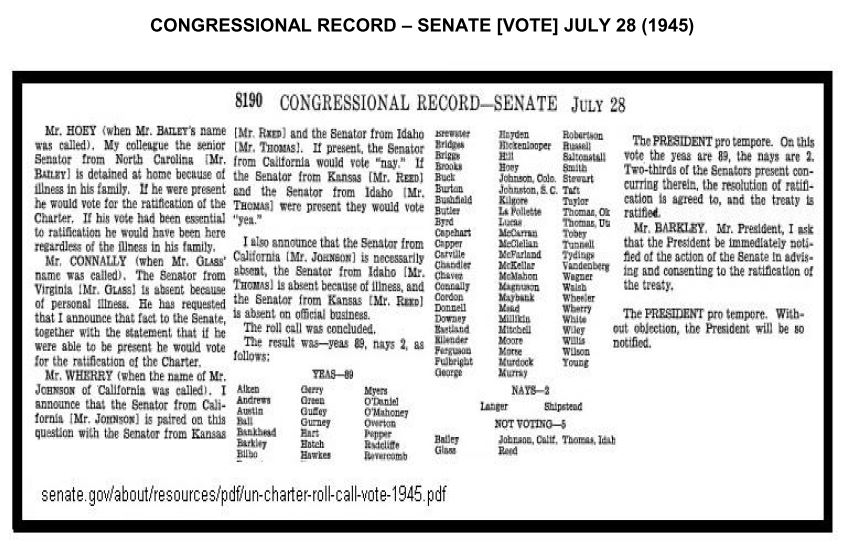
[E] The US State Department, as official Depository, has published a document showing the ratifications of the original members. This excerpt shows the initial US signing of the Charter by the Secretary of State in June of 1945 and the date in August of 1945 when President Truman signed the Charter while he was in Europe at the Potsdam Conference [4].
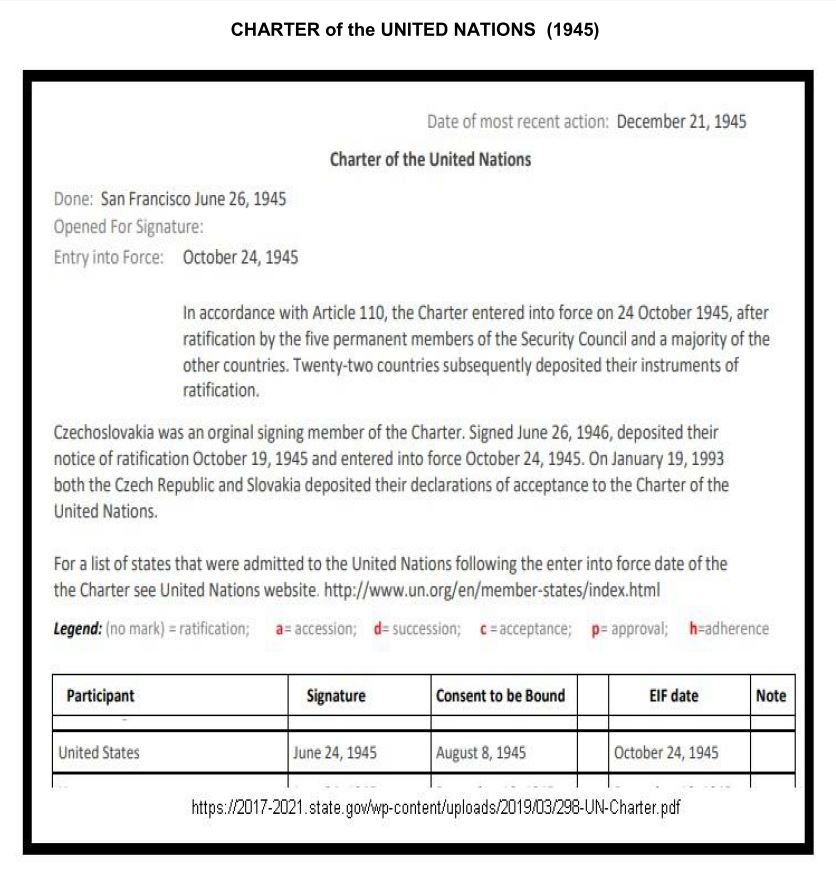
[F] While the National Archives shows a photo of President Truman signing the actual Charter on August 8, 1945. There is no record of a formal “Instrument of Ratification” on file with the Depository, as required by the Charter itself. [5] [6]
[G] The US Constitution provides, Article VI:
“This Constitution, and the Laws of the United States which shall be made in Pursuance thereof; and all Treaties made, or which shall be made, under the Authority of the United States, shall be the supreme Law of the Land; and the Judges in every State shall be bound thereby”
[H] The Vienna Convention on Treaties (VCLT) defines Treaties as contracts between sovereign states.
” Article 1 – Scope of the present Convention
The present Convention applies to treaties between States.
Article 3 – International agreements not within the scope of the present Convention
The fact that the present Convention does not apply to international agreements concluded between States and other subjects of international law…” [7]
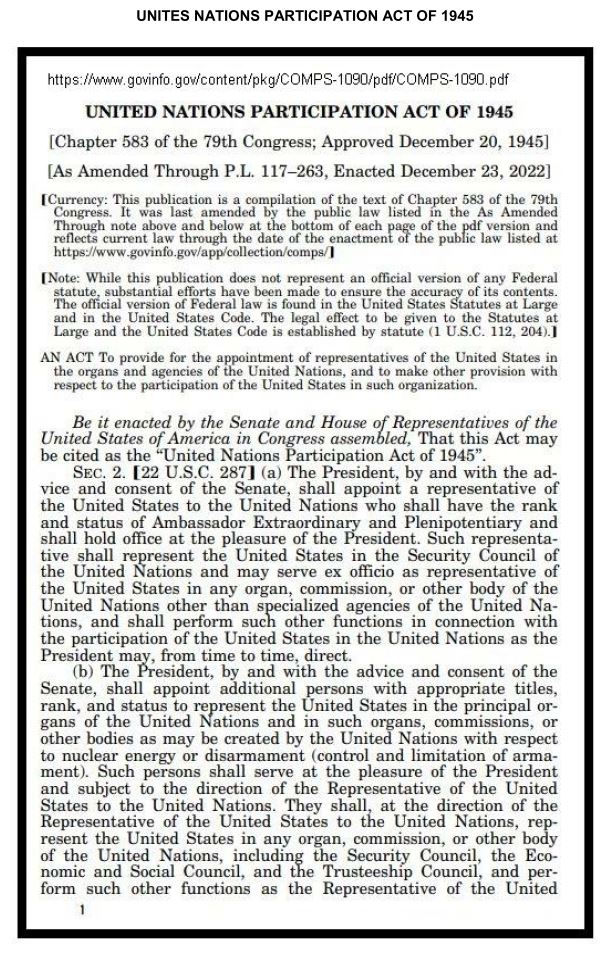
[I] Congress initially adopted the UN Participation Act in 1945 [8] after President Truman signed the Charter. While the Act provides for an ambassador-rank US Representative appointed by the President with the advice and consent of the Senate it does not authorize US participation in the United Nations.
Discussion: The United States relationship with the UN is unconstitutional, conceived in deceit, maintained in deceit and is thus ultra vires.
Harry S. Truman assumed the office of President of the United States when President Roosevelt died on April 12, 1945. Previously he had been Vice-President of the United States and President of the Senate, of which he had been a member prior to becoming Vice-President.
In an unprecedented act, Truman personally presented the United Nations Charter to the US Senate and spoke to the body in favor of participating in the UN. He stated, among other points:
“I am appearing to ask for the ratification of the Charter… in accordance with the Constitution. … For this is not a static treaty…” [9] (Emphasis added)
Although the President pro tem of the Senate inaccurately characterized the Charter of the United Nations as a “treaty” the President of the United States specified it was not a “treaty.”
This inconsistency suggests that the Senate was misinformed regarding the nature of the document. This situation is further exposed by the US State Department’s official compendium of Treaties in Force [10] and its supplement [11] which do not list the UN Charter as a Treaty in force.
The Vienna Convention on Treaties is clear: international agreements, such as Charters, are not treaties.
Therefore, by the preponderance of relevant authorities, the Charter is not a treaty. Despite the incorrect use of the word “treaty” in the Congressional Record, UN decisions do not trigger the “Supreme Law of the Land” clause of the Constitution. The UN Charter was conceived, presented and maintained by deceit. Any action by the US Government in furtherance of participation is ultra vires and void as unconstitutional.
Thus, State (and local) governments are not bound to follow UN dictates, including those issued by such subsidiary UN bodies as the World Health Organization.
The Charter explicitly differentiates between ‘Treaties’ and ‘international agreements’, stipulating that any Treaty brought before the UN must be registered with the Secretariat. The facts further show that no signatory to the UN Charter is bound, as if by a “Treaty”, to either the UN or its Member States. Nations which conclude the same international agreement do not enter into a Treaty among themselves by so doing. Section 102 of the Charter, the only Article referencing Treaties, states:
- Every treaty and every international agreement entered into by any Member of the United Nations after the present Charter comes into force shall as soon as possible be registered with the Secretariat and published by it.
- No party to any such treaty or international agreement which has not been registered in accordance with the provisions of paragraph 1 of this Article may invoke that treaty or agreement before any organ of the United Nations. [12]
The deception continues even today, since the US State Department erroneously refers to the UN Charter as a “multilateral treaty”.
“The United States is depositary for over 200 multilateral treaties – including, for example, the Charter of the United Nations, The Statute of the International Atomic Energy Agency, and the North Atlantic Treaty. In its depositary capacity, the United States keeps the original treaty texts and facilitates their signature, as appropriate. The depositary also receives instruments relating to the treaties, such as instruments of ratification, and maintains status lists of such actions.” [13]
Note that all of the United Nations ‘treaties’ listed on the various State Department compilations noted above appear to be operational agreements for various international agencies, not Treaties governing relations among States.
International conventions and agreements to form international associations, private clubs among nations, are not Treaties under Article VI of the US Constitution and as such are not binding on the Nation or its several States.
With the very recent Decision by the United States Supreme Court, Loper et al. vs Department of Commerce, overturning the traditional ‘deference’ shown by Courts to the interpretations of law by Federal Agencies, there is no special credence that we must give to the State Department’s interpretation of US treaty obligations. [14]
Continued participation in the UN and its subsidiary organizations, commitment of resources or public funding of same, on the basis of our alleged “treaty” obligations to them, is an unlawful act and must be immediately terminated.
Respectfully submitted,
Ralph Fucetola JD
Attorney at Law: 1971 – 2006
[1] http://www.sfmuseum.org/un/signing.html
[2] https://www.un.org/en/about-us/un-charter/full-text
[3] https://www.senate.gov/about/resources/pdf/un-charter-roll-call-vote-1945.pdf
[4] https://2017-2021.state.gov/wp-content/uploads/2019/03/298-UN-Charter.pdf
[5] https://www.trumanlibrary.gov/photograph-records/64-50
[6] https://history.state.gov/historicaldocuments/frus1945v01/introduction
[7] VCLT: https://legal.un.org/ilc/texts/instruments/english/conventions/1_1_1969.pdf
[8] UN Participation Act of 1945: https://www.govinfo.gov/content/pkg/COMPS-1090/pdf/COMPS-1090.pdf
[9] https://www.trumanlibrary.gov/library/public-papers/69/address-senate-urging-ratification-charter-united-nations
[10] https://www.state.gov/wp-content/uploads/2020/08/TIF-2020-Full-website-view.pdf
[11] https://www.state.gov/wp-content/uploads/2023/06/TIF-Supplement-Report-2023.pdf
[12] https://www.un.org/en/about-us/un-charter/full-text
[13] https://www.state.gov/depositary-information/
[14] https://www.scotusblog.com/2024/06/supreme-court-strikes-down-chevron-curtailing-power-of-federal-agencies/
Note: some agreements listed by the State Department as “multilateral treaties” are certainly not; for example, the Kosovo UN Security Council Resolution is on the list: https://en.wikipedia.org/wiki/United_Nations_Interim_Administration_Mission_in_Kosovo
